Why do orchid flowers wither: reasons
The reasons for wilting or discarding buds and flowers are very similar.
The difference is that a blooming orchid is more sensitive to any external factors.
Changing familiar conditions
A change in the usual environment may well cause not only wilting, but also their reset.
Orchids generally do not tolerate any changes during cultivation, especially frequent changes in the place of growth.
Preference should be given to the west or east side and try not to disturb the plant anymore by choosing a more suitable place.
Some gardeners take their pets to the country in the summer, which also causes a negative reaction - stress.
Transportation, a change in the usual place of a flowering plant ends with the dropping of flowers.
Poor lighting
It should be remembered that orchids are very sensitive to lack of light. This is especially evident during their flowering period.
With improperly selected lighting in the place of growth, the first to feel a lack of light are the buds, which begin to fade, then the petals begin to wither and as a result the entire flower falls off.
Florists often buy blooming orchids in stores or nurseries.
But it should be remembered that point-of-sale lighting is much better than home lighting.
Once in a dimly lit home room, flowers usually begin to fade and fall off.
The lack of light is created: the location of the pot is deep in the room, and even with the curtains closed.
Even tulle curtains in this arrangement significantly reduce the flow of sufficient light.
The autumn - winter season generally reduces the usefulness of lighting, and without supplementing it, the flowers will begin to fade and fall off.
Frequent watering with top dressing during flowering
Phalaenopsis is generally not recommended to be fed during the flowering period.
This causes a premature reset.
If feeding is carried out, then no more than 2 times a month and then a reduced dosage by 2-3 times.
Overheat
Direct sunlight in summer causes overheating.
Hot sun rays, falling on flowers and leaves, have a detrimental effect on phalaenopsis, causing them to wilt and discharge.
Dehumidification and subsequent processes occur during the heating season, when heat emanates from too hot batteries.
Improper watering
Overdrying the root system or waterlogging it causes a failure in the correct irrigation regime, which affects the work of the roots.
They either begin to dry out or rot. The feeding function is inhibited and the flower does not receive sufficient nutrition.
Moisture is drawn from buds and flowers. Naturally, they start to fade and fall off.
Another reason is cold watering.
Early aging of the bud
Aging in orchid growers means both the biological age of the plant and the duration of flowering.
With an advanced biological age, the orchid simply does not have enough strength to provide nutrition to the peduncles.
This usually happens after 7 years of life of this type of orchid.
You should also know: different hybrid species of phalaenopsis have different flowering times. From 10 days to six months.
It is much easier to determine the factor of dropping and wilting of flowers with this option.
Withering occurs gradually, starting from the very top.
Why it happens: the main reasons
When an orchid quickly sheds buds and flowers, one should think about why this is happening. It is necessary to analyze the system of plant care in order to help it and protect it from death. Common reasons:
Temperature violation
Orchids are sensitive to temperature changes and shed flowers when:
- Hypothermia. Inflorescences die at temperatures less than + 5 ° C. A cold window sill in winter can provoke a shedding of buds.
- Overheating from direct sunlight or radiators in winter. This injures the roots and dries out the soil.
- Sudden changes in temperature. A decrease of more than 4 ° C is a signal of the end of the flowering period.
- Drafts and excessive ventilation.
Insufficient lighting
Orchids grow buds with the growth of daylight hours. The development of buds requires more and more light. If there is not enough sunlight, the buds will fall off.
The orchid grows best on light oriental windowsills.
On the southern windowsills, flowers are shaded from the direct rays of the sun. Orchids also grow on the northern windows, but they need additional lighting. In winter cloudy weather, orchids are illuminated with fluorescent lamps up to 10-12 hours of daylight hours.
Low air humidity
The most comfortable air humidity for a blooming orchid is at least 60%. With a decrease in humidity to 50%, not only the discharge of buds begins, but also a general deterioration in the condition of the plant.
Humidity increases in one of the following ways:
- Place open bowls of water next to the plant.
- In the morning, spray the leaves and roots with water.
- Arrange a small fountain or an automated humidifier.
- Place the orchid pot on a pallet of damp expanded clay.
When placing the pot on a pallet with expanded clay, the bottom should not touch the water in order to prevent root rot from waterlogging.
Improper watering
Overdrying and waterlogging of the soil are detrimental to the orchid. The soil in the pot should be slightly damp, but not wet.
The presence of diseases and pests
An orchid may appear:
- Gray rot - gray spots form on the underside of the plant. The disease can be caused by waterlogging of the soil, hypothermia or overdose of nitrogen fertilizers.
- Root rot - manifested by the browning of the leaves, softening of the roots, which cease to provide the plant with moisture and nutrition. Treat with drugs "Fundazol", "Topsin". Processed 2-3 times after 20 days.
- Mealybug - the foliage turns yellow, a white fluffy bloom forms in the sinuses. The worm is removed with soapy water, and then the plant is sprayed with an insecticide.
Prerequisites for the complete removal of the peduncle
It is imperative to cut the peduncle when the plant is sick or weakened strongly:
- It is not able to provide food for the peduncle;
- The long flowering period weakens the plant. And he needs to provide a rest regime;
- Only completely dried peduncles are removed.
Important! Drying of the peduncle from the bottom of the stem should always cause concern and anxiety.
Cutting technology
- Determine his condition. Where there is still a living part;
- Cut with a sharp and machined tool. And treat the cut with crushed activated carbon. Or cinnamon;
- Leave a dry stump from the peduncle no more than 2-3 cm. When completely removed. Leave only 1-1.5 cm on top of a living kidney;
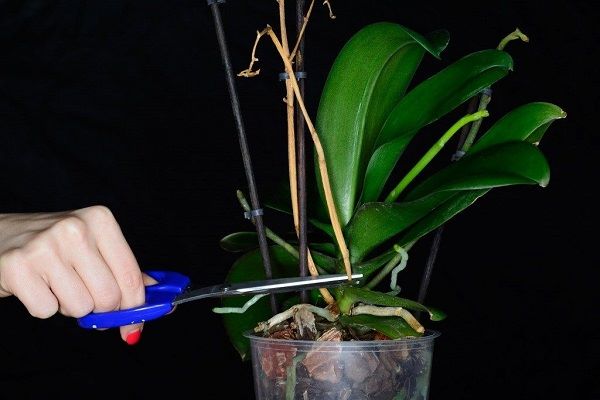
You may have your own ideas for its further use.
Features of further care
Florists do not recommend leaving dried parts on the orchid. But it is not always possible to immediately determine the reasons. And dry parts contribute to moisture loss:
- So they are removed carefully with a sharp and sterilized instrument. Whether it is a dried tip, or an entire dry peduncle;
- Remove dry and rotten roots. And leaves;
- Be sure to process the slices.
Reduce watering for a period. Refrain from feeding. Limit the flow of light.
Why buds:
Are they not blooming?
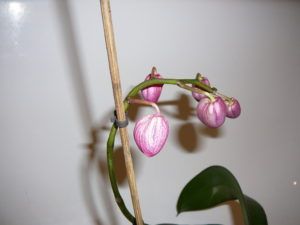 There are plenty of reasons for not opening up:
There are plenty of reasons for not opening up:
- Lack of lighting;
- Fertilization (during the period of budding and flowering, phalaenopsis do not feed);
- Moisture ingress during spraying;
- Waterlogging;
- Hot room temperature;
- Permutation during flowering, etc.
Falling down?
In phalaenopsis, at the level of genetics, blooming of flowers is laid with the onset of a dry summer period. But this is in the tropics.
We have winter at this time, therefore, for orchids in our conditions, a certain stress arises at the genetic level.
Although there are many reasons for falling, they are mainly caused by stressful situations.
What to do if the stem of an orchid dries up?
Let's find out below what to do if the orchid has faded and the stem has dried up.
From the top of the head
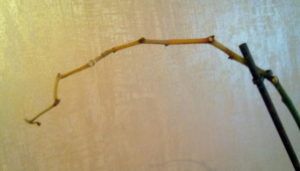 If, for some reason, the growth point of an orchid plant such as Cattleya dies, then you need to:
If, for some reason, the growth point of an orchid plant such as Cattleya dies, then you need to:
- Cut off the dying pseudo-bulb;
- And to treat fungal infections.
If at the same time create the right conditions for it, then it will continue its growth.
It is worse when a single growth point perishes in such an orchid species as Phalaenopsis. Here it is necessary to take drastic measures to save the plant. If this is a rapidly developing rot, then the plant has practically no chance.
If the loss of a growth point is a consequence of drying out or mechanical injury, then here you can help the orchid like this:
- The dried stem is cut to a healthy living place;
- And they are treated with fungicide for fungal diseases and wood ash.
For these reasons, the stem dries from the crown of the orchid.
Further care for such an injured bush must follow all the rules.
It is necessary to pay attention to the following parameters for care:
- Watering;
- Lighting;
- Top dressing with preparations for orchid plants with a higher proportion of nitrogen;
-
Indoor temperature.
After a long time, reaching up to six months, the flower will release lateral children. They are deposited only when they reach their normal size. That is, the roots will be up to 5 cm long and there will be a rosette of 2-3 leaves.
IMPORTANT! It is better to plan a transplant in the spring, so there will be more chances for new orchid babies to survive.
After flowering
Many growers observe that after flowering on an orchid, the trunk dries up. Only on some does it dry out completely, on others only partially. What to do with such a peduncle?
Causes
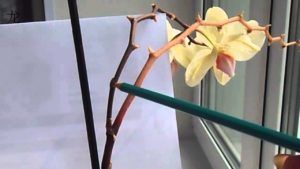 It can dry out for 2 reasons:
It can dry out for 2 reasons:
- Natural process;
- Improper plant care.
In the first case, after flowering, part of the old stem may begin to dry out, while it changes the light. If you cut it to a healthy waiting bud, then the plant will continue its growth after a certain time, growing children on the remaining trunk.
Signs of improper care when the trunk dries up:
- Excess or lack of moisture;
- Excess lighting;
- Fungus or harmful insects.
If the peduncle was released by the plant from the point of growth, then this will serve as an impetus for the drying of the stem.
Treatment measures
If this plant has pseudobulbs, then they are not removed even with partial drying out, if there are still unprocessed peduncles on it. If this is Phalaenopsis and the flower arrow has dried up after flowering, then it is removed in whole or in part. It depends on the desire of the grower and on how much the arrow has dried.
If completely, then the dried peduncle is completely removed. And if the florist wants to continue the flowering of his orchid and the peduncle has not yet completely dried out, then they cut it to a living place 2 cm above the waiting bud and wait for the continuation of flowering.
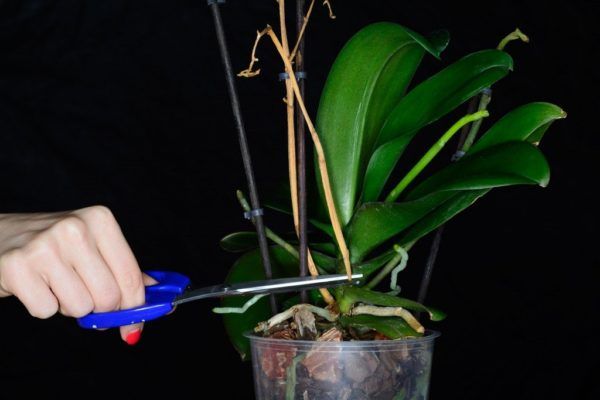
After flowering, the dried stem of the orchid is cut off.
If it really is the stem that dries, then it is cut off with a pruner, which is pre-sterilized in alcohol. They are adjusting the maintenance regime and waiting for the appearance of children.
IMPORTANT! After pruning with pruning shears, treat the cut with wood ash.
Insufficient watering
If the irrigation regime is violated, the plant may also begin to turn yellow leaves. After all, an orchid is a tropical plant and therefore it is painful to lose moisture.
How can you tell if a plant is too dry?
With a long dry period, the leaves of the flower wrinkle from moisture loss, and at the same time yellowness occurs along the lower leaf plates.
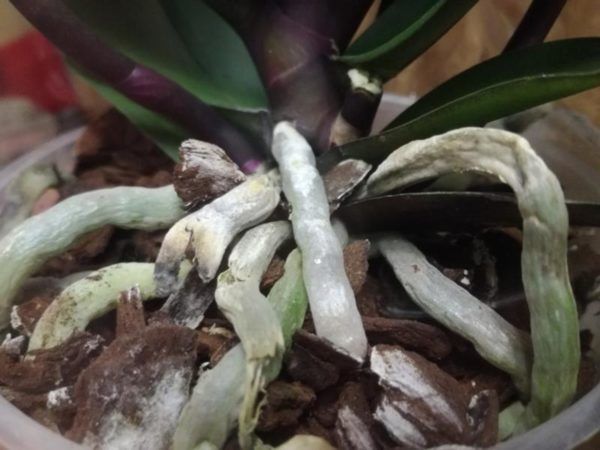
Drying out of the orchid can also be determined by the roots.
Added to this is the loss of leaf turgor throughout the entire bush. Indeed, for the development of roots, which the orchid primarily does, it takes strength from the leaf mass. If the flower is often in a dry state, it begins to dry the lower plates of the leaves, taking nutrients from them. Orchid leaves often fall off.
IMPORTANT! When kept dry, the bark is always dry and dries deep enough into the container. This is clearly visible, since orchids are usually grown in transparent containers.
How should the plant be watered when dry?
After drying, the flower needs to be replenished. Therefore, you can use the bottom watering method. 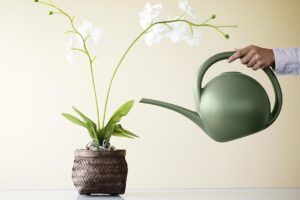 For this:
For this:
- We put a container with a flower in water and leave it there, not as usual, for 20 minutes, but let it stand in the water for at least a day;
- After removing from the water, the pot will be quite heavy due to the fact that the bark will pick up a lot of moisture;
- The leaves will become firm again in 5-6 days. This time is necessary for moisture from the roots to reach each cell of the leaf;
- We do the next watering as usual and when there is no condensation on the inner wall of the pot.
IMPORTANT! This method can be used if the root system of the plant is not damaged. It is impossible to arrange such bathing systematically.
What does excessive watering lead to?
A constant excess with water leads to:
- To decay of the root mass;
- And infection with various fungal infections of orchid leaves.
To prevent this from happening, it is necessary to correctly observe the frequency of watering and not flood the plant.
Humidity: optimal value
Lack of moisture or too much moisture is the most common cause of problems. An acute shortage of moisture occurs if, for some reason, watering is stopped. In this case, resuscitation cannot be avoided!
Instructions for action in this case:
Pour water at room temperature into the basin to a level of no more than 15-20 cm.
Immerse in a bowl of water and wait until the earthen lump becomes limp.
Please note that the leaves must be dry when immersed in the basin!
If the earthen lump is too limp, it is necessary to place the patient in a new pot.
Content that is too wet creates another serious problem: Phalaenopsis starts to rot. Affected by rot, the flower loses its foliage, the leaves become soft, the flowers fall off.
Decay is always easier to prevent than to cure. If 90% of the plant is infected, then it will die!
It is important to take timely measures and eliminate the causes of rot:
- Remove the flower from the pot.
- Rinse the roots under warm running water.
- Remove damaged roots, leaves.
- Remove wilted flowers.
- Treat the sections with an antiseptic.
- Leave to dry overnight.
- Transplant the orchid into new soil with a drainage layer.
- Water only when the soil is dry.
Antiseptics for orchids: Fundazol, Fitosporin. Treatment of rot wounds: Chlorhexidine. After reading such detailed instructions, the question remains: how to properly water an orchid?
Age and lighting

Even if a plant is well looked after, this does not mean that it will bloom forever. If the phalaenopsis is already more than seven years old, then even with additional fertilizers its flowering will be reduced to two months. Therefore, it is worth buying an orchid only in flower shops, where you can ask its age, since in large supermarkets this cannot be found out and you will have to navigate by the type of plant. If the orchid has already dropped its buds, then this indicates the approach of the end of its development. However, it must be remembered that flowers are also subject to the natural aging process.
Note. At home, the life span of phalaenopsis is noticeably reduced, most often this is the main reason why the buds of an orchid fall off .. She tries to bloom until the end of her life period, but there is simply not enough strength for full development, and therefore the flower:
She tries to bloom until the end of her life period, but she simply does not have enough strength for full development, and therefore the flower:
- throws out the arrow;
- forms buds;
- and then dries up, not even having time to bloom.
If the care was attentive, but the flowers still crumble, then it's time to remember how old the orchid is.
If the unblown buds of an orchid fall off, then there may be a lack of lighting in the room. When purchasing a plant from a store, you need to take into account that the lighting is better there and, once in a new place after purchase, the flowers may fall off. Much less light will fall on the flower if it stands far from the window, and even tulle can become an obstacle to sunlight, especially in winter. Therefore, a suitable place should be chosen in advance so as not to cause stress and not provoke shedding of flowers. If there is not enough light in the room, then the flowers of the plant fall off, and then the buds wither.
 You may be interested in:
You may be interested in:
Why the orchid does not bloom: what to do, the basic rules Orchid is a delicate flower that requires special care, both on the site and at home. Florists are often surprised ... Read more ...
Flower processing options
One of the main reasons that an orchid can throw off unblown buds are various diseases that manifest themselves as spots and bumps on the leaves: they can turn yellow and dry out. It is possible to fight them by carrying out processing of flowers to prevent the development of pathologies and the reproduction of parasites on them.
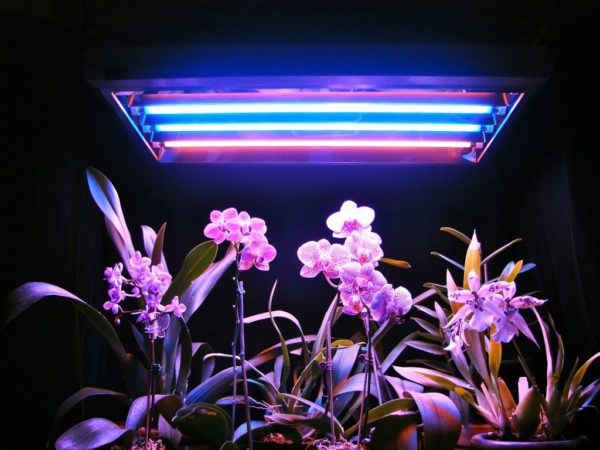
Supplementing orchids with lamps
There are many types of pest treatment products on sale, both special chemical (including numerous fungicides against fungal infections), and biological products, organic compounds. In addition, you can use the centuries-old folk floriculture experience.
Chemicals
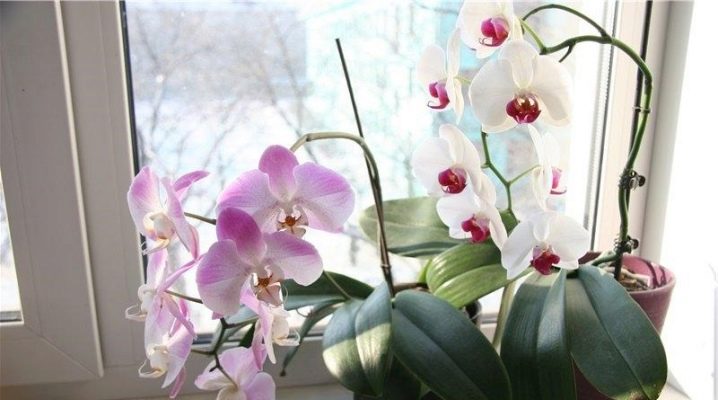
These are means of a quick and very effective response. They are divided into 4 hazard classes, they must be used strictly for the intended purpose and the dosage must be observed, otherwise you can harm yourself and the green pet. The most popular among orchid lovers are drugs such as:
- Fitoverm;
- Inta-Vir;
- Aktara;
- Tanrek;
- "Confidor".
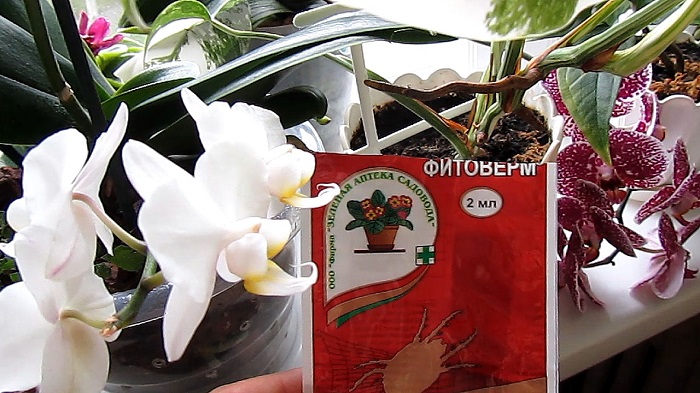
"Fitoverm" - a chemical preparation for the treatment of orchids
Fungicide "Fitosporin" works well against fungal infections of orchids, which can also be used for prophylaxis during plant transplantation and subsequent pruning.
Along with chemicals, bio-preparations for protecting flowers are produced. Plants do not accumulate them, and pests do not develop resistance. In addition, biological agents serve to enhance the immunity of orchids. Florists recommend fast acting preparations:
- "Bicol";
- "Bitoxibaccillin";
- "Lepidocide";
- "Verticillin";
- "Aversectin C";
- "Nemabakt".

"Lepidocid" - a biological product for processing flowers
If you don't want to resort to chemistry, you can stop at folk remedies for processing flowers:
Soap solution: from 1 liter of water and 1 tbsp. spoons of liquid soap (or grated household soap), with which the stems and foliage are wiped.
Additional Information. Ordinary dishwashing detergent will work as well.
- Tobacco tincture: for 1 liter of water, take up to 40 grams of tobacco, ground into dust, insist for 24 hours, then strain and spray Phalaenopsis from a spray bottle.
- Infusion of an onion, mashed and poured with 1 liter of boiling water, insist for 7 hours and apply to the leaves and stem. The course is 3-4 days, you should not get carried away, otherwise the plant may dry out.
- Dried citrus peels (100 grams) are poured with a liter of water and infused for a couple of days, with this infusion the diseased plant is sprayed every few hours for a week. Dry orange and tangerine peels can be used to cover the soil in a pot.
- The well-known hydrogen peroxide is used to treat orchids and other indoor plants in order to disinfect foliage and substrate from microbes, mites and insect pests.
Advice
When using this drug, you should observe moderation and caution, otherwise the plant will begin to wilt before our eyes.
Caring for a blooming orchid includes ensuring normal lighting, optimal watering, and suitable temperature conditions of 22-26 degrees. The need to moisten a flower is judged by the presence or absence of condensation on the walls of the pot. In this case, watering is carried out by placing a flower pot in a container with water.
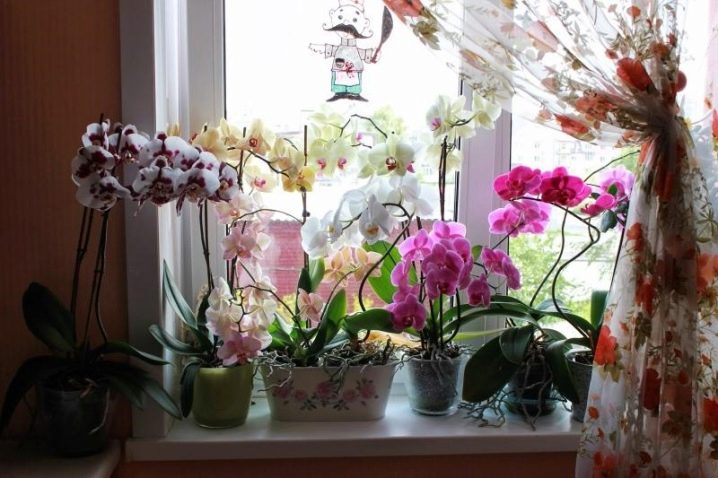
The air around the orchid should also be humidified with a spray bottle, it is recommended to keep the air humidity at 45-60 percent.
Note! If the flowering of Phalaenopsis meets the standards and pleases the eye, you do not need to transfer the flower to another place - this can serve as stress for it, and the buds will begin to fall off. Top dressing is a very important point in the care of this exotic flower.
Orchids should be fed during intensive growth and ejection of flower stalks, while using special feeding specially designed for this type of plant. The flower is soaked directly in the pot, the concentrated mixture is added to the water and left for 10-20 minutes, after which the excess liquid is drained. It is advisable to carry out such a manipulation once every half a month.
Top dressing is a very important point in the care of this exotic flower. Orchids should be fed during intensive growth and ejection of flower stalks, while using special feeding specially designed for this type of plant. The flower is soaked directly in the pot, the concentrated mixture is added to the water and left for 10-20 minutes, after which the excess liquid is drained. It is advisable to carry out such manipulation once every fortnight.
Lack of lighting
Why did the orchid leaves turn yellow and fell off? In winter and autumn, when the weather is cloudy in all regions, orchids lack sunlight. At this time, the leaves lose their color. They do not turn yellow, but they seem to fade compared to summer.
 To prevent this fading from turning into yellow, the plant needs backlighting on cloudy days. Indeed, for normal development, a flower needs 8-10 hours of illumination. In low light, the buds also dry out, since the flower does not have enough strength to open them.
To prevent this fading from turning into yellow, the plant needs backlighting on cloudy days. Indeed, for normal development, a flower needs 8-10 hours of illumination. In low light, the buds also dry out, since the flower does not have enough strength to open them.
Therefore, those who do not have southern window sills should purchase phytolamps in specialized stores. They will help to cope with the lack of light.
IMPORTANT! Phytolamps are placed at a certain distance from the plants so as not to cause heat burns on the body of the orchids.
Changing the color of the growth point of monopodial orchids
The base of the top leaf, from where growth continues, is the point of growth of the orchid. The reason for the yellowing of the growth point is:
- Suboptimal growing conditions;
- Failure to comply with the watering regime;
- Infectious diseases.
Important! Orchid roots do not tolerate stagnant water well, so the remaining moisture from the pallets must be drained.
If the damage to the growth point is too severe, the orchid will stop growing upward and will most likely die.
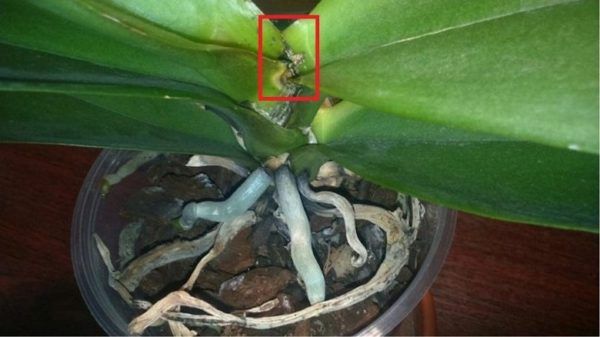
If the growth point is damaged, the orchid dies.
If, thanks to good immunity, the orchid survives, then it can form a baby on the stem or flowering arrow and continue to grow.
Aging leaves is not a reason to panic
One or even two yellowed leaves on an orchid do not give cause for great concern. This is how the natural aging process of the leaves can be manifested. The leaf of each plant has its own lifespan. Leaves are replaced gradually. In common orchids such as Cattleya or Pafiopedilum, the lower leaves turn yellow and fall off. Less often, two leaves may turn yellow and fall off. In orchids from the genus Dendrobium, the bulbs can be completely leafless.In this case, you do not need to take any measures, this is a natural process, the old leaf turns yellow, dries completely and disappears on its own. You should not help the plant in this process, cutting or tearing off the leaves.
In this case, the yellowing of the leaves proceeds very quickly. The leaf turns yellow in 1–4 days. Much depends on the age of the flower. The leaves themselves remain on the plant for several years, after which they fall off. This is as normal as fall leaves in autumn.

Conclusion
On the one hand, orchids are not very whimsical plants, on the other hand, they are quite capricious when grown in an ordinary city apartment.
 Even the slightest mistakes in care affect flowering, which causes the termination of this amazing process, for the sake of which a tropical beauty is acquired.
Even the slightest mistakes in care affect flowering, which causes the termination of this amazing process, for the sake of which a tropical beauty is acquired.
In addition to the reasons considered, there are a number of other that can cause flowers to fall:
- pests;
- bees;
- nearby fruits and vegetables emitted by ethylene.
Only the study of the biological properties and the implementation of the recommendations of experienced orchid growers will help to avoid such a negative situation for the orchid owner.


